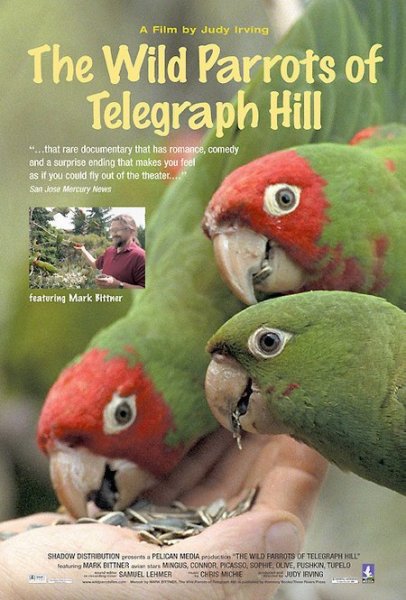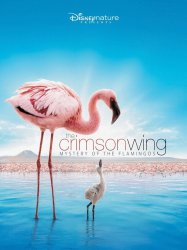The Wild Parrots of Telegraph Hill is a american film of genre Documentary released in USA on 9 october 2003
The Wild Parrots of Telegraph Hill (2003)

If you like this film, let us know!
- Infos
- Casting
- Technical infos
- Photos
- Videos
- Film quotes
- Characters
- Music
- Awards
Released in USA 9 october 2003
Length 1h23
OriginUSA
Genres Documentary
Themes Films about animals, Documentary films about cities, Films about birds, Documentary films about nature
Rating77%










The Wild Parrots of Telegraph Hill is a 2003 documentary film directed, produced, and edited by Judy Irving. It chronicles the relationship between Mark Bittner, an unemployed musician who is living rent-free in a cabin in Telegraph Hill in San Francisco, California, and a flock of feral parrots that he feeds and interacts with -- cherry-headed conures, mainly, but also two blue-crowned conures, one of which is named Connor. Bittner also wrote a book by the same name on the subject.
In May 2007, the documentary aired on the PBS series Independent Lens.
Much of the documentary focuses on the individual parrots, and their relationships with one another. Bittner notes that there is humor in the piece, which he believes makes it different from many other nature documentaries.
Raising funding for the film was difficult at first, as Irving had to find individual donors. The proceeds from a fundraiser, in which Bittner gave a presentation to a packed theater, allowed Irving to start shooting the film in earnest.
The musical score was created by Chris Michie, a Bay area musician, formerly the guitarist for Van Morrison. It was his final project before he died from melanoma. The film, which he did not live to see released, is dedicated to him.
Comments
Leave comment :
Suggestions of similar film to The Wild Parrots of Telegraph Hill
There are 8968 with the same cinematographic genres, 4035 films with the same themes (including 0 films with the same 4 themes than The Wild Parrots of Telegraph Hill), to have finally 70 suggestions of similar films.If you liked The Wild Parrots of Telegraph Hill, you will probably like those similar films :

Dealing Dogs (2006)
, 1h15Origin USA
Genres Documentary
Themes Films about animals, Environmental films, Documentary films about animal rights, Documentary films about law, Documentary films about cities, Films about dogs, Political films, Documentary films about nature
Rating80%





The film involves an undercover investigation by LCA's special investigations unit of Martin Creek Kennel in Williford, Arkansas, an alleged "Class B" dealer. A member of the unit obtains a job at the kennel and documents deplorable conditions: dead dogs, dying dogs, starving dogs, dogs covered with wounds, dogs with missing ears. Partially as a result of the documentation, the kennel was permanently shut down by federal authorities.

Wild Wings (1965)
, 34minutesOrigin United-kingdom
Genres Documentary
Themes Films about animals, Transport films, Rail transport films, Documentary films about technology, Films about birds, Documentary films about nature
Rating65%





 , 1h22
, 1h22Directed by Luc Jacquet
Origin France
Genres Documentary, Adventure
Themes Films about animals, Environmental films, Documentaire animalier, Documentary films about environmental issues, Films about birds, Documentary films about nature, Films about penguins, Children's films
Actors Lambert Wilson, Morgan Freeman, Sofie Gråbøl, Heikki Kinnunen, Pierfrancesco Diliberto, Thomas Acda
Rating66%





Un tout jeune manchot empereur apprend à vivre dans l'environnement hostile de l'Antarctique, sous le regard de son père qui veille sur les premiers mois de sa vie.

March of the Penguins (2005)
, 1h24Directed by Luc Jacquet
Origin France
Genres Documentary
Themes Films about animals, Environmental films, Documentaire animalier, Documentary films about environmental issues, Films about birds, Documentary films about nature, Films about penguins, Ecologie
Actors Romane Bohringer, Charles Berling, Jules Sitruk, Morgan Freeman, Torsten Michaelis, Andrea-Kathrin Loewig
Rating74%





Les manchots empereurs vivent en colonie en Antarctique. Au milieu de leurs congénères, chaque couple de manchots lutte contre les conditions extrêmes pour perpétuer l'espèce et protéger leur petit des nombreux obstacles et dangers qui les guettent. Chaque année est un cycle qui voit la naissance d'un seul petit manchot par couple, dont beaucoup n'atteindront pas l'âge adulte, voire n'auront pas la chance de naître. Outre le grand froid, le vent et les tempêtes, ils affrontent des prédateurs tels que le léopard de mer et le pétrel géant. Les parents alternent entre protection de l'œuf puis du petit dans l'intérieur des terres (plus stable et protégé que la banquise) et pêche sur le littoral. Des kilomètres de marche sont alors nécessaires pour utiliser les avantages de ces deux territoires alors que le manchot, bien plus à l'aise dans l'eau, est incapable de voler et se déplace avec difficulté sur le continent.

Best Friend Forgotten (2004)
, 1h40Directed by Julie Friedman Steele
Origin USA
Genres Documentary
Themes Films about animals, Environmental films, Documentary films about animal rights, Documentary films about law, Documentary films about cities, Political films, Documentary films about nature
Rating80%






Genres Documentary
Themes Films about animals, Films about birds, Documentary films about nature, Films about penguins
Rating58%





 , 1h14
, 1h14Origin USA
Genres Documentary
Themes Films set in Africa, Films about animals, Environmental films, Documentary films about environmental issues, Films about birds, Documentary films about nature, Children's films
Actors Zabou Breitman, Karoline Herfurth
Rating72%





The film documents the lives of lesser flamingos on the isolated shores of Lake Natron in northern Tanzania, revealing the breeding and parenting habits of the species. After mating, the flamingos breed chicks that grow up, always on the move trying to enjoy their lives. Along their journeys, they encounter vicious marabou storks who kill many unborn and newly born chicks and a villainous spotted hyena who takes no pity on the elderly flamingos.

Sun Dogs (2006)
Origin Canada
Genres Documentary
Themes Films about animals, Sports films, Documentary films about sports, Documentary films about cities, Films about dogs, Documentary films about nature
Rating62%





Rescued from the mean streets and animal shelters of Kingston, 12 stray dogs are trained to be the stars of Jamaica’s first dogsled racing team. The crew, spearheaded by pop superstar Jimmy Buffett, brings the unlikely meeting of a traditionally snow-bound sport to the sand and surf.

Of Penguins and Men (2004)
, 52minutesDirected by Luc Jacquet
Origin France
Genres Documentary
Themes Films about animals, Films about films, Environmental films, Documentaire animalier, Documentary films about the film industry, Documentary films about environmental issues, Films about birds, Documentary films about nature, Documentary films about films, Films about penguins
Actors Luc Jacquet
Rating70%





Le périple d'une équipe de cinéastes animaliers dont l'ambition est de filmer l'extraordinaire cycle de vie des manchots empereurs.

Street Dogs of South Central (2013)
Origin USA
Genres Documentary
Themes Films about animals, Documentary films about cities, Films about dogs, Documentary films about nature
Rating79%





 Connection
Connection